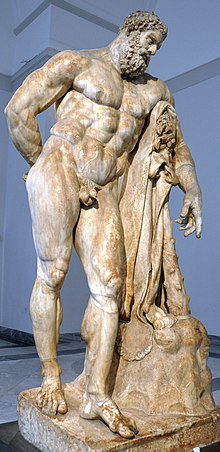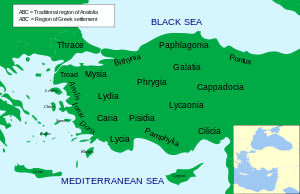|
Greek city of Amorion (Amorium) in Phrygia
Bronze 16mm (3.39 grams) Struck circa 133-27 B.C.
Reference: Rare, possibly unpublished type
Head of Hercules right wearing lion-skin headdress.
AMOPIANΩN, Eagle standing right, head left.
You are bidding on the exact item pictured, provided with a Certificate of Authenticity and Lifetime Guarantee of Authenticity.
  Heracles, born Alcaeus (Alkaios) or Alcides, was a divine hero in Greek mythology, the son of Zeus and Alcmene, foster son of Amphitryon and great-grandson and half-brother (as they are both sired by the god Zeus) of Perseus. He was the greatest of the Greek heroes, a paragon of masculinity, the ancestor of royal clans who claimed to be Heracleidae and a champion of the Olympian order against chthonic monsters. In Rome and the modern West, he is known as Hercules, with whom the later Roman emperors, in particular Commodus and Maximian, often identified themselves. The Romans adopted the Greek version of his life and works essentially unchanged, but added anecdotal detail of their own, some of it linking the hero with the geography of the Central Mediterranean. Details of his cult were adapted to Rome as well. Heracles, born Alcaeus (Alkaios) or Alcides, was a divine hero in Greek mythology, the son of Zeus and Alcmene, foster son of Amphitryon and great-grandson and half-brother (as they are both sired by the god Zeus) of Perseus. He was the greatest of the Greek heroes, a paragon of masculinity, the ancestor of royal clans who claimed to be Heracleidae and a champion of the Olympian order against chthonic monsters. In Rome and the modern West, he is known as Hercules, with whom the later Roman emperors, in particular Commodus and Maximian, often identified themselves. The Romans adopted the Greek version of his life and works essentially unchanged, but added anecdotal detail of their own, some of it linking the hero with the geography of the Central Mediterranean. Details of his cult were adapted to Rome as well.
Extraordinary strength, courage, ingenuity, and sexual prowess with both males and females were among the characteristics commonly attributed to him. Heracles used his wits on several occasions when his strength did not suffice, such as when laboring for the king Augeas of Elis, wrestling the giant Antaeus, or tricking Atlas into taking the sky back onto his shoulders. Together with Hermes he was the patron and protector of gymnasia and palaestrae. His iconographic attributes are the lion skin and the club. These qualities did not prevent him from being regarded as a playful figure who used games to relax from his labors and played a great deal with children. By conquering dangerous archaic forces he is said to have “made the world safe for mankind” and to be its benefactor. Heracles was an extremely passionate and emotional individual, capable of doing both great deeds for his friends (such as wrestling with Thanatos on behalf of Prince Admetus, who had regaled Heracles with his hospitality, or restoring his friend Tyndareus to the throne of Sparta after he was overthrown) and being a terrible enemy who would wreak horrible vengeance on those who crossed him, as Augeas, Neleus and Laomedon all found out to their cost.
Amorium was a city in Phrygia, Asia Minor which was founded in the Hellenistic period, flourished under the Byzantine Empire, and declined after the Arab sack of 838. It was situated on the Byzantine military road from Constantinople to Cilicia. Its ruins and höyük (‘mound, tumulus’) are located under and around the modern village of Hisarköy, 13 kilometers east of the district center, Emirdağ, Afyonkarahisar Province, Turkey. Amorium is the Latinized version of its original Greek name Amorion (Greek: Ἀμόριον). Arab/Islamic sources refer to the city as ʿAmmūriye. Under Ottoman rule the site, which never regained importance, was called Hergen Kale or Hergen Kaleh.
Antiquity
The city minted its own coins beginning between 133 BC to 27 BC until the 3rd century AD, indicating its maturity as a settlement and military importance during the pre-Byzantine period. Amorium then must have been prestigious and prosperous. But early historical records that mention the city are strictly limited to a reference by Strabo, although it is expected that new discoveries will shed light on the city’s Roman period and before.
Byzantine period
The city was fortified by the emperor Zeno in the 5th century, but did not rise to prominence until the 7th century. Its strategic location in central Asia Minor made the city a vital stronghold against the armies of the Umayyad Caliphate following the Muslim conquest of the Levant. The city was first attacked by Muawiyah I in 646. It capitulated to ‘Abd ar-Rahman ibn Khalid in 666 and was occupied by Yazid I in 669, then retaken by Constans II’s general Andreas. Over the next two centuries, it remained a frequent target of Muslim raids (razzias) into Asia Minor, especially during the great sieges of 716 and 796. It became capital of the thema of Anatolikon soon after. In 742-743, it was the main base of Emperor Constantine V against the usurper Artabasdos, and in 820, an Amorian, Michael II, ascended the Byzantine throne, establishing the Amorian dynasty. This began the period of the city’s greatest prosperity, when it became the largest city in Asia Minor. Its status however as the native city of the reigning dynasty also spelled its doom: in 838, the Caliph Al-Mu’tasim launched a campaign specifically against the city, which was captured and razed, an episode recounted in a poem of Abu Tammam.
The town was rebuilt, but was burned by Thamal al-Dulafi in 931. Nonetheless, it remained an active Byzantine city at least into the 11th century. Following the Battle of Manzikert, it was devastated by the Seljuks and a large proportion of its inhabitants were killed. Emperor Alexios I Komnenos defeated the Seljuks at Amorium in 1116, but the area was never recovered.
It remained an important place in the 12th-14th centuries according to al-Idrisi and Hamdallah Mustawfi.
 In antiquity, Phrygia was a kingdom in the west central part of Anatolia, in what is now Turkey, centered on the Sakarya River. In antiquity, Phrygia was a kingdom in the west central part of Anatolia, in what is now Turkey, centered on the Sakarya River.
During the heroic age of Greek mythology, several legendary kings were Phrygians: Gordias whose Gordian Knot would later be cut by Alexander the Great, Midas who turned whatever he touched to gold, and Mygdon who warred with the Amazons. According to Homer’s Iliad, the Phrygians were close allies of the Trojans and participants in the Trojan War against the Achaeans. Phrygian power reached its peak in the late 8th century BC under another, historical, king: Midas, who dominated most of western and central Anatolia and rivaled Assyria and Urartu for power in eastern Anatolia. This later Midas was, however, also the last independent king of Phrygia before its capital Gordium was sacked by Cimmerians around 695 BC. Phrygia then became subject to Lydia, and then successively to Persia, Alexander and his Hellenistic successors, Pergamon, Rome and Byzantium. Phrygians were gradually assimilated into other cultures by the early medieval era, and after the Turkish conquest of Anatolia the name Phrygia passed out of usage as a territorial designation.
|






 Heracles, born Alcaeus (Alkaios) or Alcides, was a divine hero in Greek mythology, the son of Zeus and Alcmene, foster son of Amphitryon and great-grandson and half-brother (as they are both sired by the god Zeus) of Perseus. He was the greatest of the Greek heroes, a paragon of masculinity, the ancestor of royal clans who claimed to be Heracleidae and a champion of the Olympian order against chthonic monsters. In Rome and the modern West, he is known as Hercules, with whom the later Roman emperors, in particular Commodus and Maximian, often identified themselves. The Romans adopted the Greek version of his life and works essentially unchanged, but added anecdotal detail of their own, some of it linking the hero with the geography of the Central Mediterranean. Details of his cult were adapted to Rome as well.
Heracles, born Alcaeus (Alkaios) or Alcides, was a divine hero in Greek mythology, the son of Zeus and Alcmene, foster son of Amphitryon and great-grandson and half-brother (as they are both sired by the god Zeus) of Perseus. He was the greatest of the Greek heroes, a paragon of masculinity, the ancestor of royal clans who claimed to be Heracleidae and a champion of the Olympian order against chthonic monsters. In Rome and the modern West, he is known as Hercules, with whom the later Roman emperors, in particular Commodus and Maximian, often identified themselves. The Romans adopted the Greek version of his life and works essentially unchanged, but added anecdotal detail of their own, some of it linking the hero with the geography of the Central Mediterranean. Details of his cult were adapted to Rome as well. In antiquity, Phrygia was a kingdom in the west central part of Anatolia, in what is now Turkey, centered on the Sakarya River.
In antiquity, Phrygia was a kingdom in the west central part of Anatolia, in what is now Turkey, centered on the Sakarya River.




